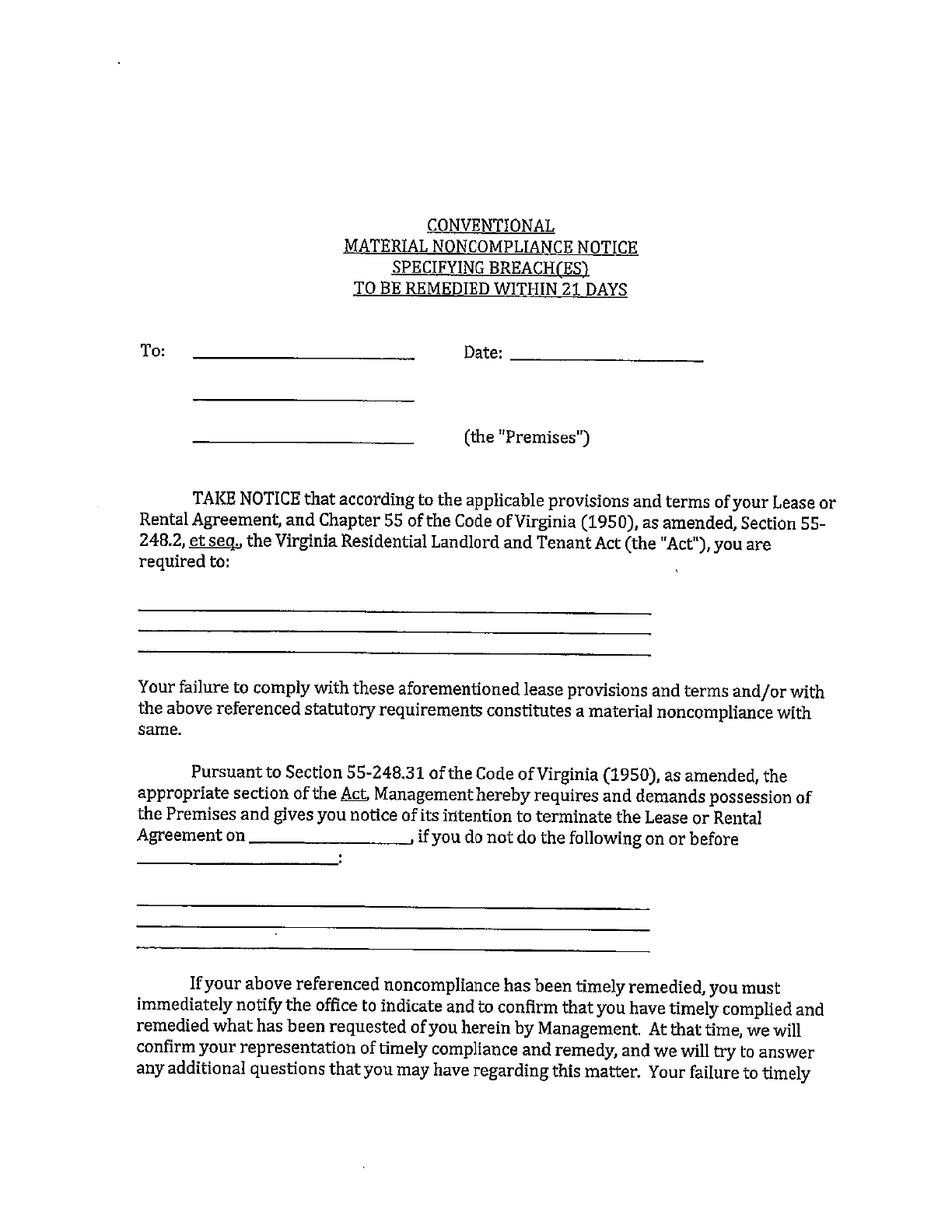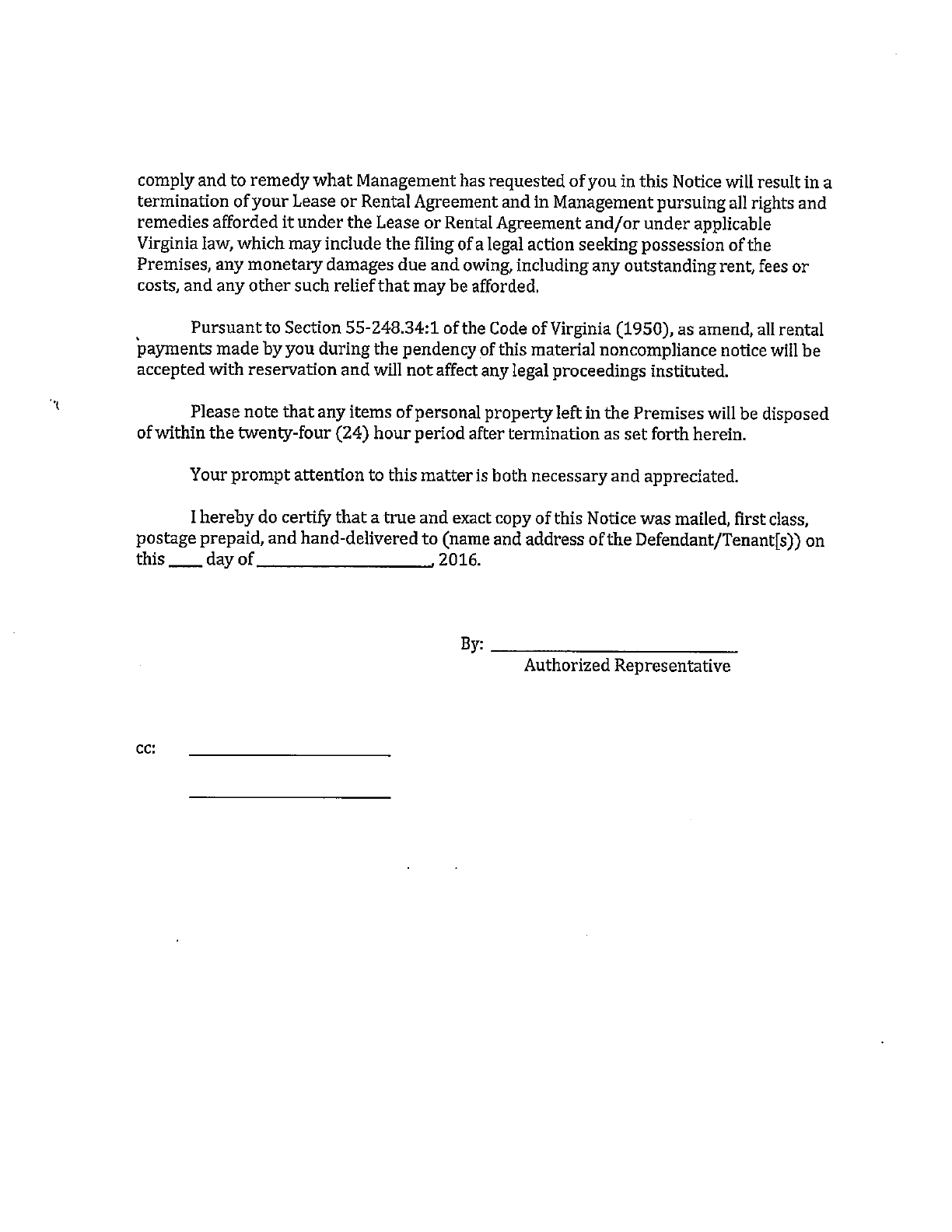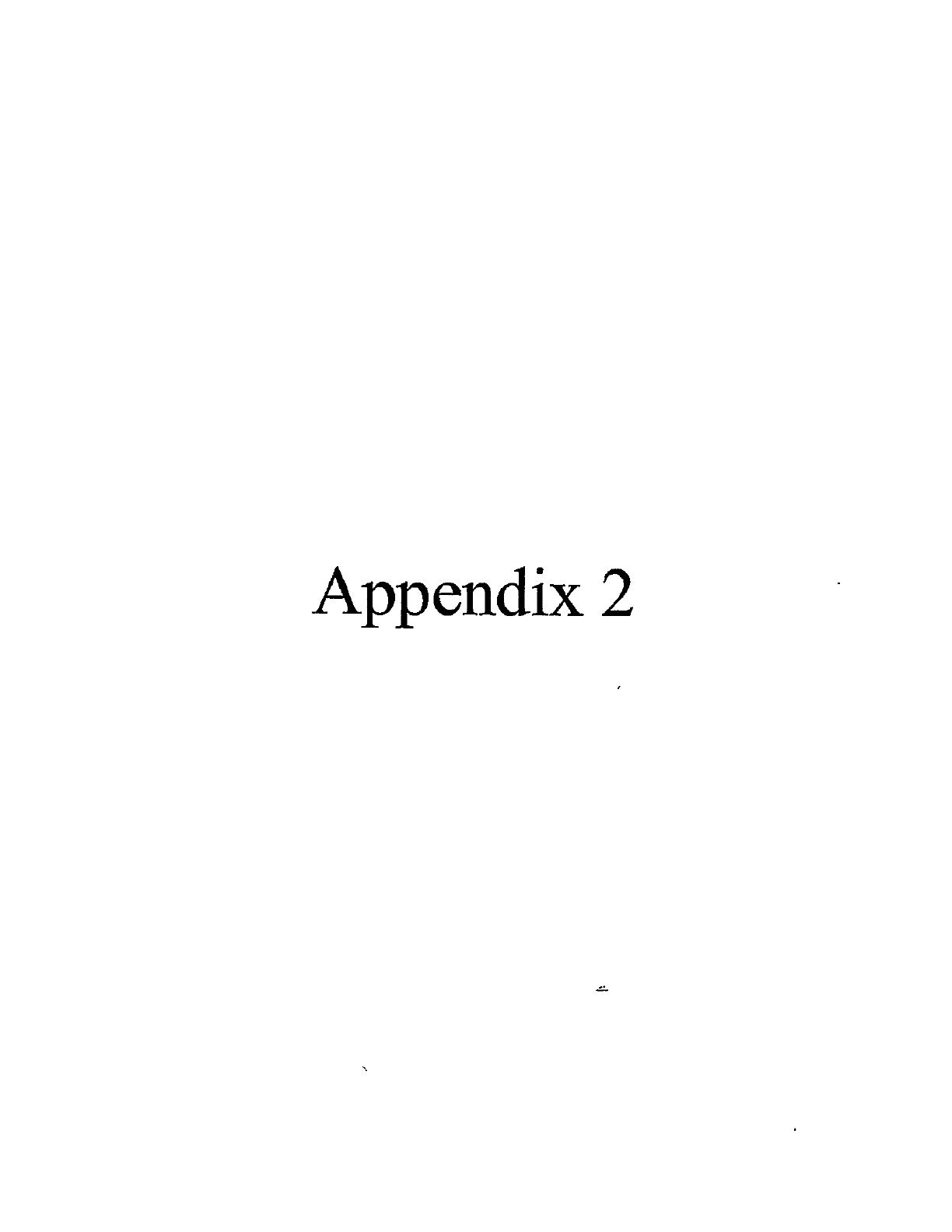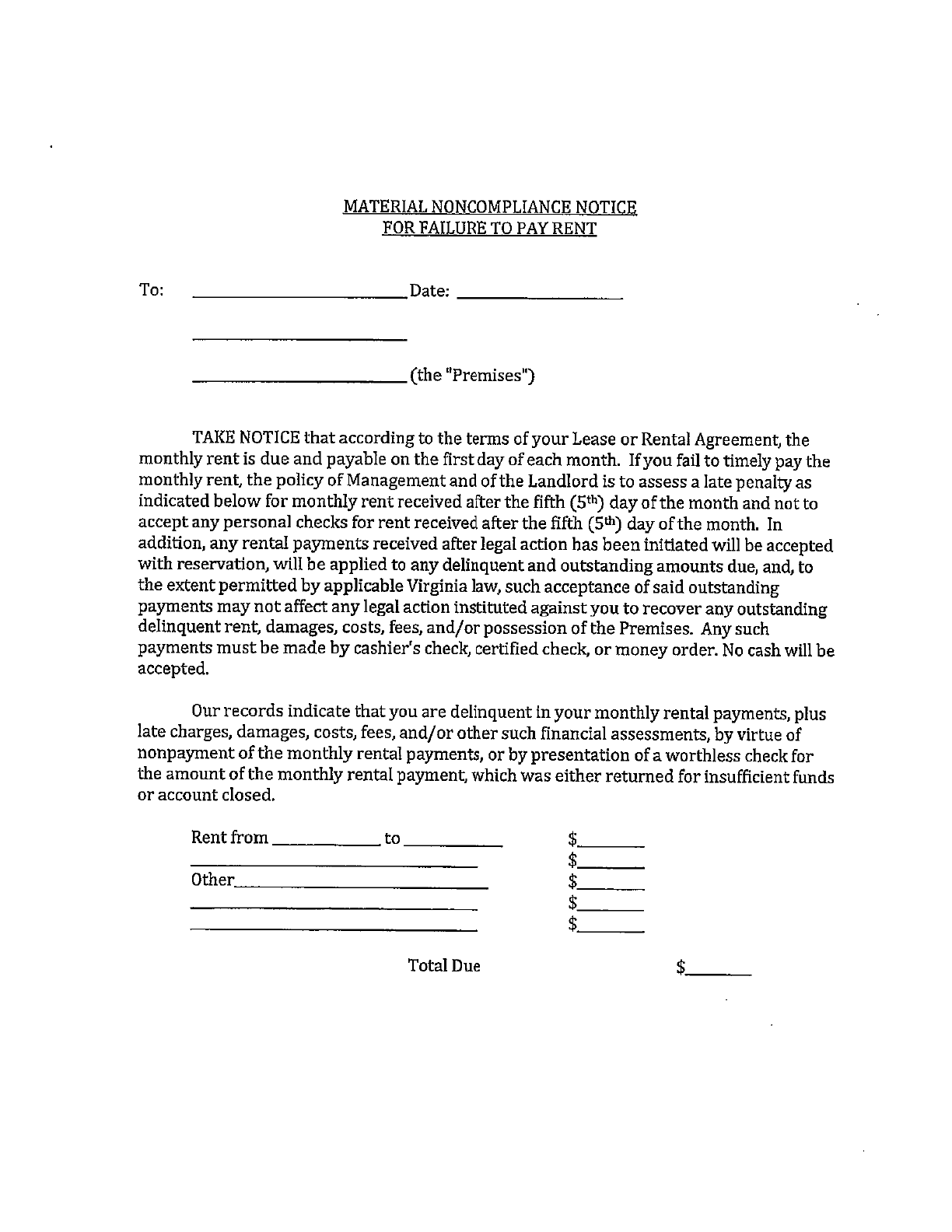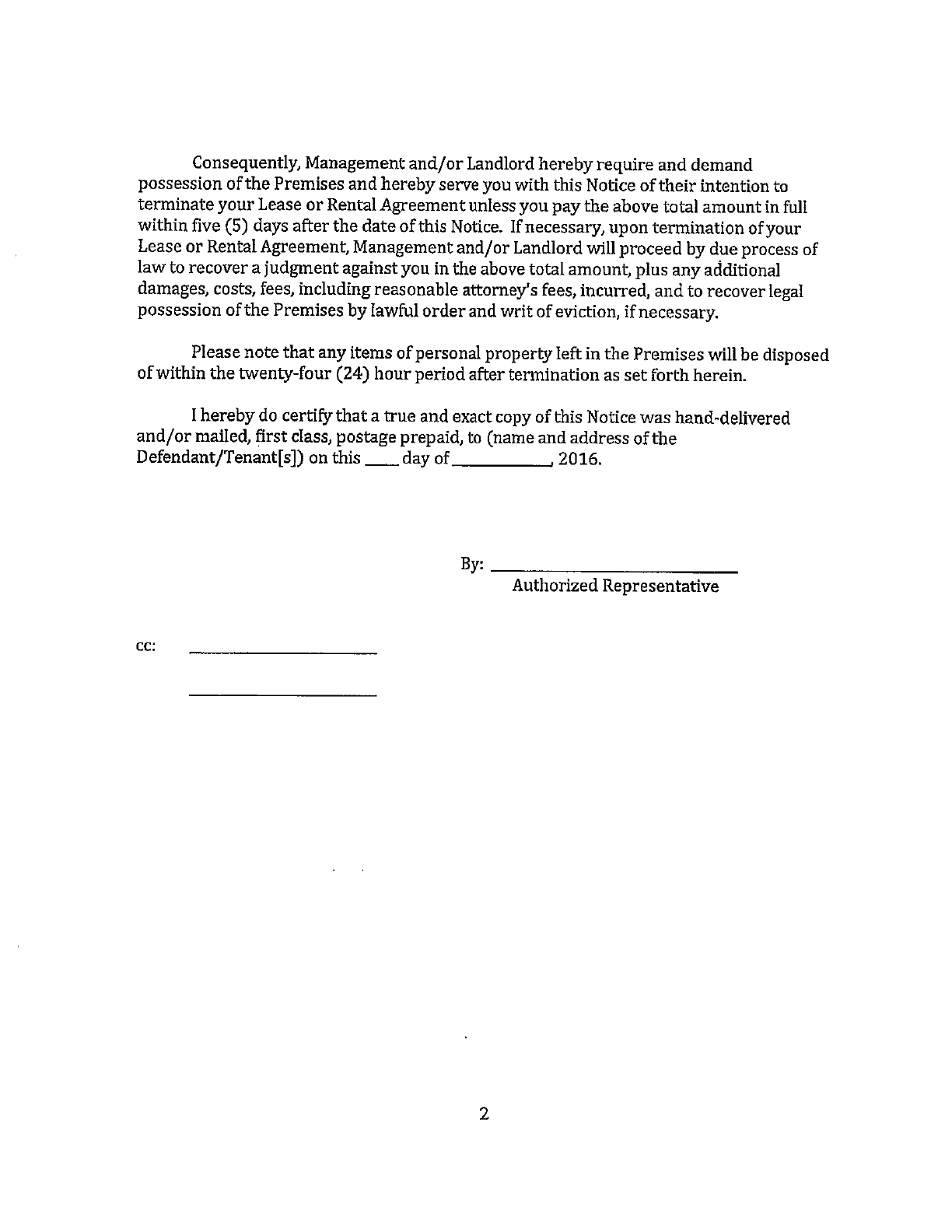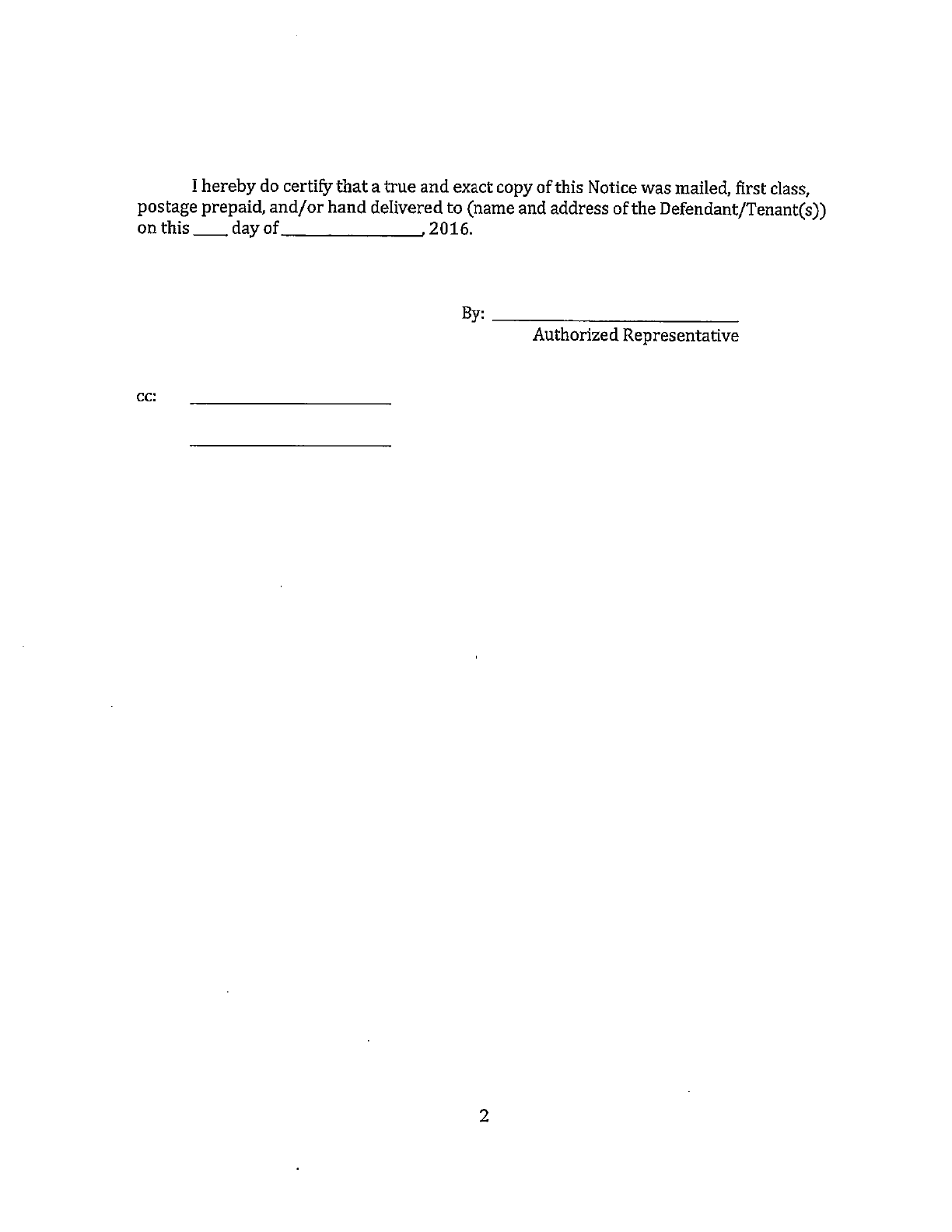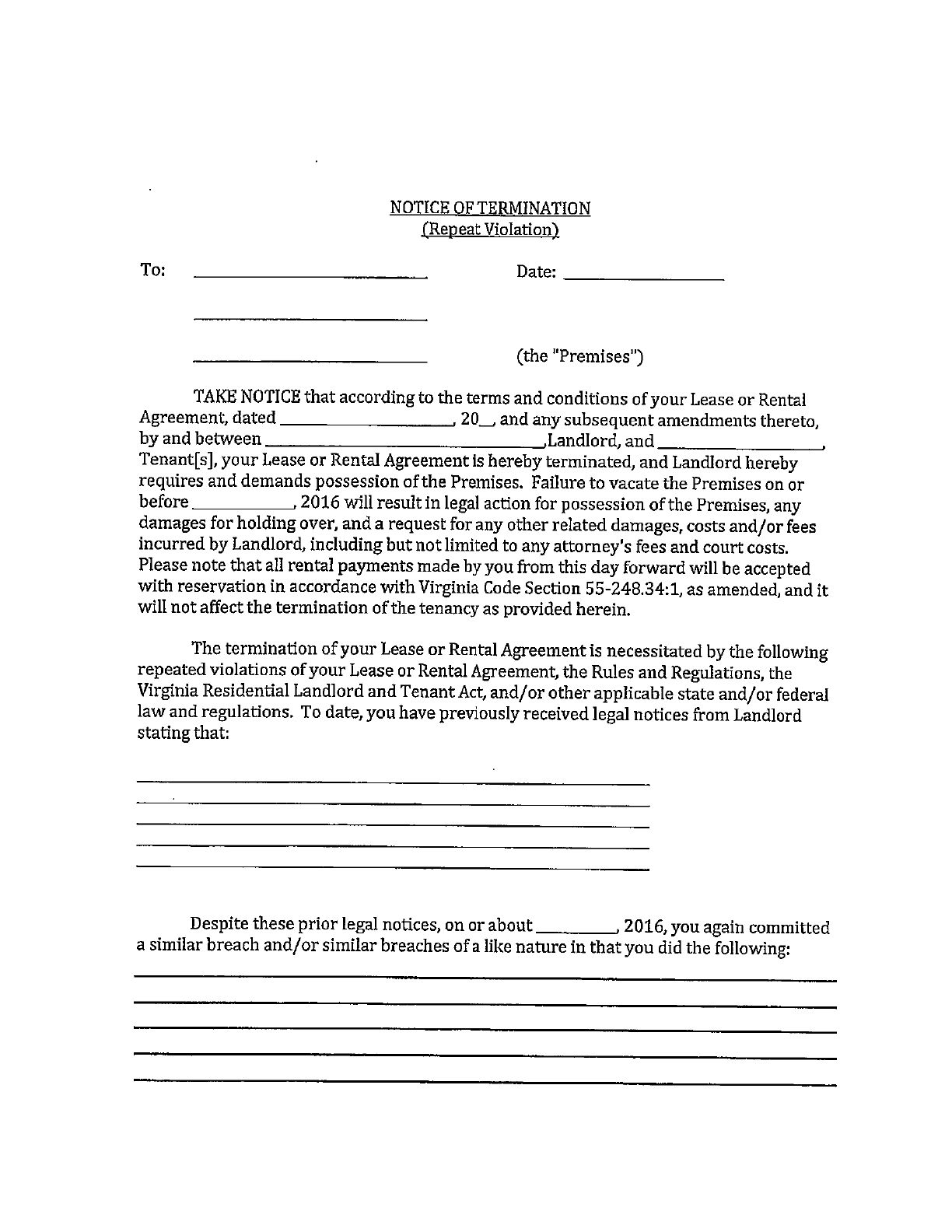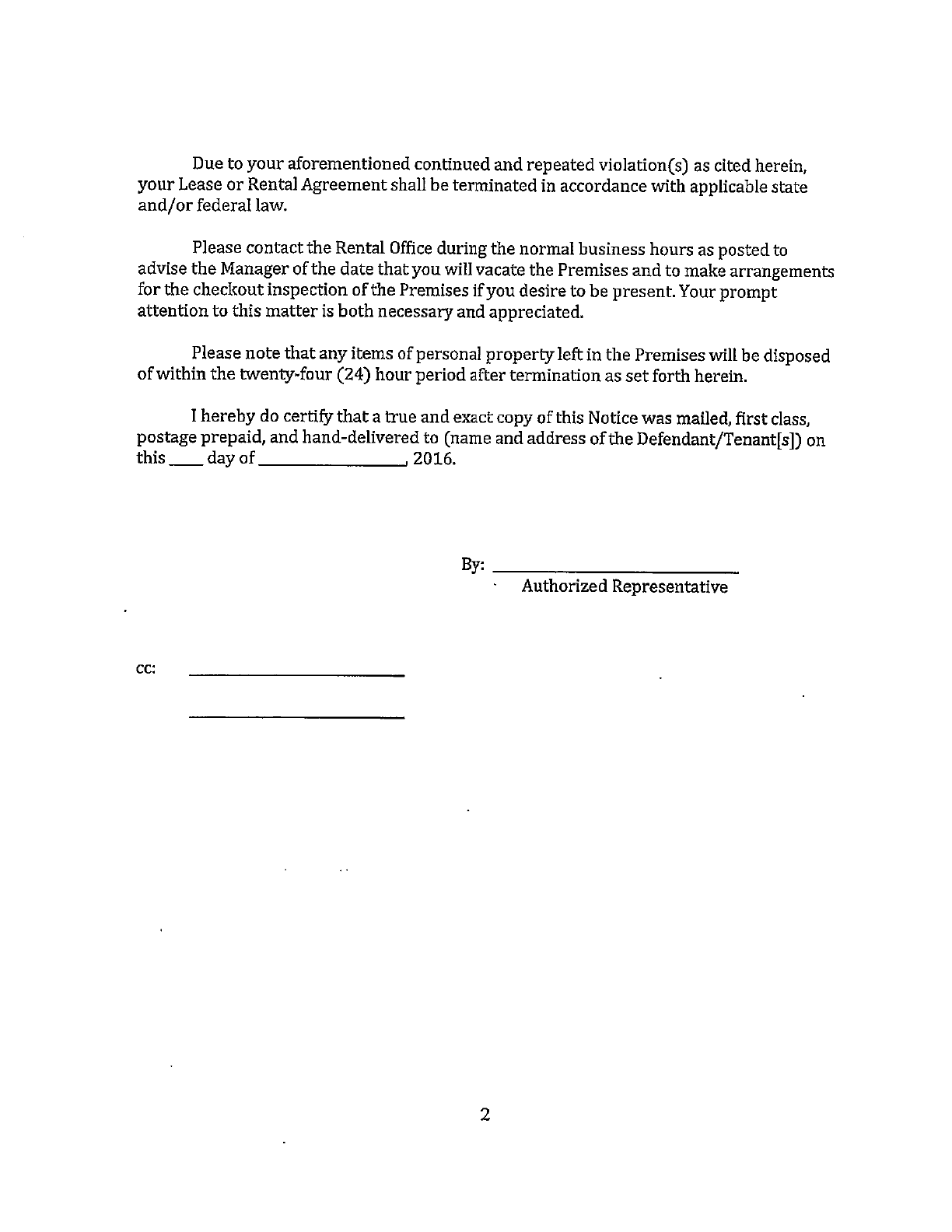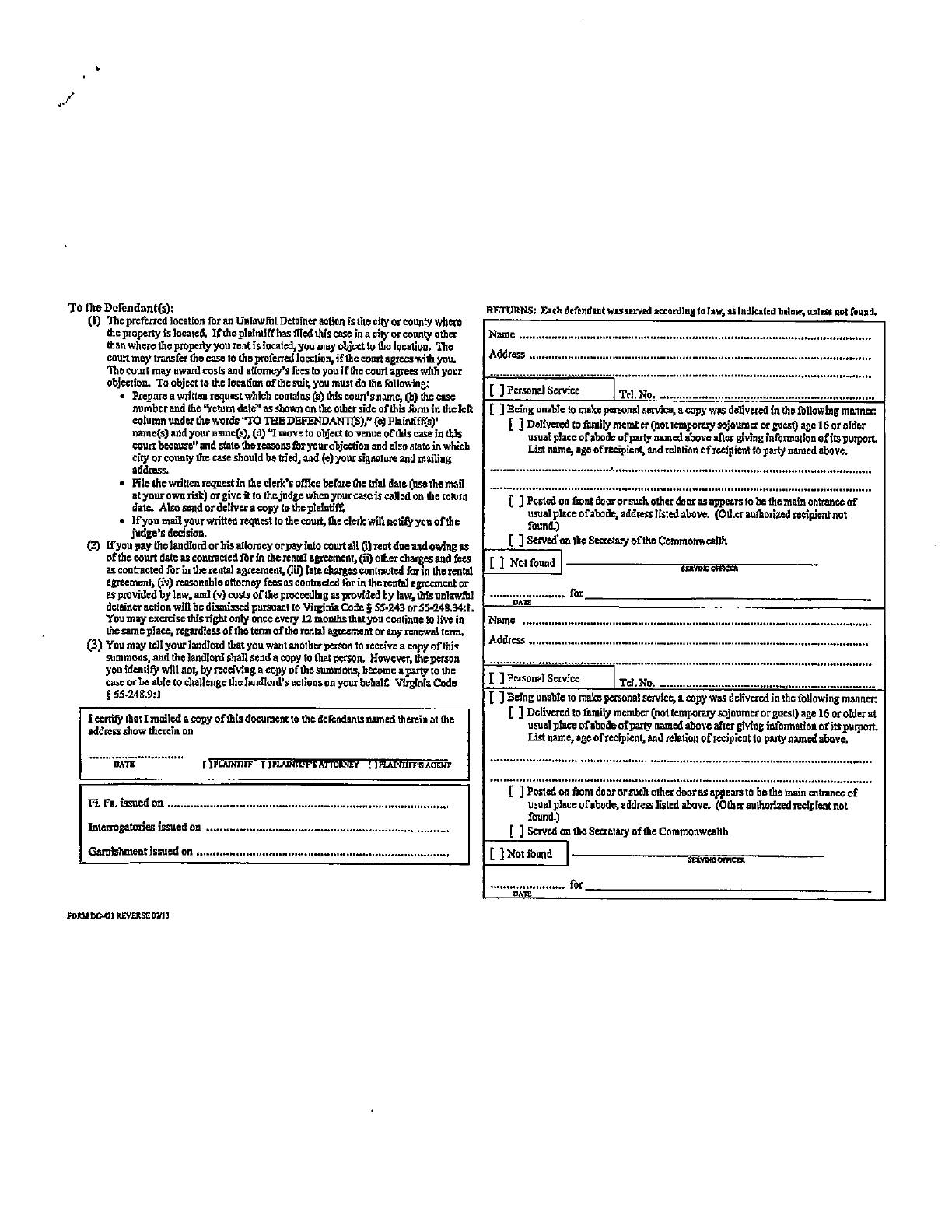
A GUIDE TO VIRGINIA RESIDENTIAL
LANDLORD & TENANT LAW
Bryan Grimes Creasy
Johnson, Ayers & Matthews, P.L.C.
310 First Street – Suite 700
Roanoke, Virginia 24011
Phone: (540) 767-2000
Fax: (540) 982-1552
UNLAWFUL DETAINER ACTIONS UNDER VIRGINIA LAW
Landlords are in the business of maximizing the total number of occupants within
a property’s available living space. A high occupancy rate equates to a high cash inflow.
Therefore, in general, eviction is not a welcome procedure as the eviction of a tenant
results in a vacancy and a loss of expected revenue. Nonetheless, when a tenant is
unwilling or unable to abide by the terms of a lease agreement, the tenant must be
removed quickly and efficiently. Non-paying and problem tenants make property
management difficult and frustrating. A protracted eviction process will result in lost
potential revenue and lost opportunity costs. In those situations, a clean and quick
eviction process is an important and helpful tool for landlords. During the course of an
eviction, issues of outstanding rent, late fees, damages, and attorneys’ fees will be sought
and disputed by the respective parties. This outline will review how these issues are
addressed under applicable Virginia law.
Please note that there are exceptions as to what properties are covered by the
Virginia Residential Landlord and Tenant Act (“VRLTA”).
1
However, with the
reduction of the trigger number under Virginia Code Section 55-248.3:1(B), the majority
of residential leases will now be covered by the VRLTA. Further, in recent legislative
sessions, the General Assembly has begun placing multiple sections of the VRLTA into
the Landlord and Tenant Act
2
, which has significantly reduced the differences between
the two Acts. Therefore, this outline will focus primarily on the eviction process for
VRLTA properties. Although there are still remaining differences between the VRLTA
and the Landlord and Tenant Act, the VRLTA is more comprehensive and more often
relied upon and referred to in unlawful detainer actions than the Landlord and Tenant
Act. Thus, the VRLTA will be the main focus and subject of this outline and CLE
course. Differences between the two Acts will be noted along each step of the guide.
STEP ONE - Identify a Breach of the Lease
Property managers and landlords often articulate problems created by tenants, but
they routinely fail to link the tenant’s behavior with a particular lease provision or
applicable statute. Property managers and landlords must be instructed to identify the
1
Virginia Code Sections 55-248.2 through 55-248.40.
2
Virginia Code Sections 55-217 through 55-248.

Page 2 of 24
precise nature of the breach, and they have to be instructed to detail the underlying breach
in the subject notice.
The following are common examples of instances whereby a tenant breaches a
lease agreement or statutory provision:
Example 1: Failure to pay rent
o Although one would assume that landlords quickly address tenants who
fail to pay monthly rent; however, landlords regularly fail to address this
issue quickly. Landlord’s often accept a partial payment and hope that the
tenant’s next payment will be for the full amount owed. Once a tenant
starts to fall behind, non-payment usually follows, which becomes
compounded with the imposition of late fees. Thus, landlords should
adhere to a consistent policy of sending notices unless they receive the full
rent amount.
Example 2: Breach of quiet enjoyment
o Well written leases contain a provision requiring that a tenant respect the
quiet enjoyment of the leased premises and common areas. Situations
often arise whereby tenants cause disturbances disrupting other tenants.
Practitioners should encourage their landlord/property manager clients to
document any such incidents. Thorough documentation will make success
during the trial phase more likely. Landlords should send 21/30 material
non-compliance notices following such a breach. The number of 21/30
notices to be sent prior to filling a Summons for Unlawful Detainer is
usually dictated by the severity of the breach.
Example 3: Failure to abide by occupancy restrictions
o Most leases require the prospect to list individuals, who will be living on
the premises. Many leases also require that only those individuals listed in
the lease reside on the premises. On occasion, tenants will permit
unauthorized friends and family to move into the leased premises. These
situations are difficult for property managers and landlords to detect and to
prove. Mail carriers may report to the staff when a given residence
receives large amounts of mail to an unauthorized person within the leased
premises. Property managers should also look for unregistered vehicles
parked in the housing community lot.
Example 4: Failure to maintain utilities and services
o Tenants generally maintain the utilities as a necessity for sustainable
living. In some cases, tenants may fail to maintain the proper utilities.
Landlords and property managers should move quickly against such

Page 3 of 24
tenants to avoid property damage, especially in extreme weather
conditions.
Questions:
1) Can a landlord change the locks on the apartment and lock the tenant out
following a breach of the lease?
Absolutely not. Virginia Code Sections 55-225.1 and 55-248.36 expressly
prohibit the landlord from recovering possession except by lawful and permitted
means. Consequently, Virginia law no longer recognizes the right of “self-help”
in residential landlord and tenant situations. Self-help remedies are still available
in non-residential tenancies. (See Va. Code § 55-225)
2) Can a landlord dispose of the tenant’s furniture following a breach of the
lease and/or apparent abandonment?
Items of personal property left in the leased premises at the end of the tenancy are
to be treated as abandoned property, which will require the landlord to comply
with Virginia Code Section 55-248.38:1. In such a scenario, prior to disposing of
any abandoned property, including furniture, the landlord must provide the former
resident with the appropriate notice as set forth under the aforementioned code
section. If possession was obtained by lawful Court order and by way of a writ of
eviction, then the personal property may be disposed of in accordance with
Virginia Code Section 55-248.38:2. Also please refer to Step Nine for additional
information.
STEP TWO - Serve the Proper Notice
Under the VRLTA, notices are an integral part of a good landlord-tenant practice.
Pursuant to Virginia Code Section 55-248.6, the VRLTA deems notice of a fact when a
person:
o has actual knowledge of a fact, or
o has received verbal notice of the fact, or
o has reason to know that such a fact exists.
The VRLTA defines “Notice” as one:
o given in writing by either regular mail or hand delivery, with the sender
retaining sufficient proof of having given such notice, which may be either
a United States postal certificate of mailing or a certificate of service
confirming such mailing prepared by sender; or
o if the rental agreement so provides, notice may be sent in electronic form.
(See Virginia Code Section 55-248.6(B))

Page 4 of 24
Notice is served on the landlord at his place of business where the lease
agreement was made or at any place the landlord represents to be a place for receipt of
communication. Notice is served on the tenant at his last known place of residence,
which may be the dwelling unit. Notice received by an organization is effective for a
particular transaction at the time it is brought to the attention of the person conducting the
transaction, or from the time it would have been brought to his attention if the
organization had exercised reasonable diligence.
No notice to quit or notice of termination of tenancy served on a public housing
tenant is effective unless it contains on the first page, the name, address, and telephone
number of the legal services program, if any, serving the jurisdiction in which the rental
premises are located.
Notices must set forth the proper time periods permitting the tenant an
opportunity to remedy his breach or a statutory time period within which to surrender
possession of the premises, as required by the VRLTA. If the property is governed by
HUD such as a Section 8 based property, the notices must also strictly comply with the
applicable HUD regulations and guidelines.
Examples:
Example 1: 21/30 Material Non-Compliance Notice
Pursuant to Virginia Code Section 55-248.31, a 21/30 material non-compliance
notice should be sent to tenants when they breach the lease in such a way that the breach
could be remedied and cured.
3
For example, assume a hypothetical situation whereby neighbors complain about
a particular tenant’s loud and disturbing behavior, to which the landlord may send this
notice to indicate that the tenant has 21 days within which to remedy his breach of the
lease for his failure to comply with the lease’s quiet enjoyment provision. Should the
landlord receive any further verifiable complaints within 21 days, the tenant must vacate
the premises within 30 days from the date of the notice. On the other hand, if the tenant
does not violate the quiet enjoyment provision, then he may remain on the premises
through the duration of the lease term, provided there are no other breaches of the lease.
Example 2: Material Non-Compliance for Failure to Pay Rent
Pursuant to Virginia Code Section 55-248.31, this notice should be used when a
tenant fails to pay rent. This notice provides the tenant with an additional five days
within which to pay rent. Should the tenant fail to make payment for the amount due and
owing (including late fees), the owner may proceed with a Court proceeding to obtain a
money judgment, possession, and attorneys’ fees and costs, if applicable.
4
3
See a sample 21/30 Material Non-Compliance Notice attached as Appendix 1.
4
See a sample Material Non-Compliance Notice for Failure to Pay Rent attached as Appendix 2.

Page 5 of 24
Example 3: Notice of Termination – Non-Remediable Violation
Pursuant to Virginia Code Section 55-248.31(C), this notice should be used in
situations whereby the tenant breaches the lease in such a way that there is no remedy.
This notice results in termination of the lease agreement. The tenant is permitted to
remain on the property for no less than 30 days upon receipt of this notice. This notice is
often utilized when the tenant takes part in criminal or illegal drug activity.
5
If the non-
remediable breach constitutes a criminal or willful act, which is not remediable and
which poses a threat to health or safety, the landlord may give the tenant an immediate
non-remediable breach of lease notice; commonly referred to as a 72 hour notice.
Example 4: Notice of Termination – Repeat Violation
This notice should be served on tenants when the subject breach of the lease
agreement is repeated in a similar or serial manner. For example, when a tenant violates a
quiet enjoyment provision of a lease, the owners may send a 21/30 notice. Then the
tenant may remedy the breach by not causing disruptions within the 21-day period. If, at
some point afterward the tenant violates the quiet enjoyment provision of the lease
agreement again, then this notice should be sent to the tenant to inform him of his
repeated violation. The notice requests possession of the premises within a period no less
than 30 days from the date of the notice.
6
Questions:
1) What actions should a landlord’s attorney take when the landlord has served
the wrong notice and there is a pending unlawful detainer return date?
To properly posture a landlord’s unlawful detainer action, the landlord must have
served the tenant with the appropriate notice in accordance with Virginia Code
Section 55-248.31. In the event the landlord served an incorrect notice, then the
defendant is afforded an opportunity to have the case dismissed based on that
error. Consequently, the landlord will be faced with one of two options. First,
nonsuit the pending unlawful detainer action, properly serve the correct notice,
and then re-file the unlawful detainer action. In the alternative, the case can be
continued to a date far enough in advance to allow the landlord to serve the proper
notice and to allow for that notice period to expire before then proceeding with
setting the unlawful detainer action for a trial on the merits. The one problem
with the second option is that you technically have a case pending prior to and
during the time that the termination notice is pending, which procedurally is not
the proper sequence. Thus, a nonsuit of the pending action would appear to be
more appropriate.
5
See a sample Notice of Termination – Non-Remediable Violation attached as Appendix 3.
6
See a sample Notice of Termination – Repeat Violation Notice attached as Appendix 4.

Page 6 of 24
STEP THREE - Identify and Compile the Proper Documentation
In preparation for the return date, the attorney should procure the following:
o a copy of the lease agreement;
o the relevant notice served following the breach and the attempted eviction,
o a copy of the account ledger indicating the amounts outstanding, if any;
o acceptance of rent with reservation notices, and if necessary an abstract of
a prior summons for unlawful detainer action that was dismissed per the
one right of redemption, (See Virginia Code Section 55-248.34:1); and
o affidavit per Virginia Code Section 8.01-126 - (See Step Six for further
discussion).
If the notices served on the tenant by the landlord or property manager are not the
proper notices, then the plaintiff’s case is defective. The attorney should request a
nonsuit to allow time for his client to correct the problems and to serve the proper notice.
After the landlord or property manager serves the proper notice and after the termination
period expires, the plaintiff’s attorney should re-file the unlawful detainer action using
the proper notice as its base. By taking these steps, the plaintiff’s case will be properly
positioned prior to the trial. (See also Question 1 in Step Two)
Depending on the jurisdiction, some General District Court judges prefer to hear
the contested matter at the time of the return date, instead of setting the matter for a
contested date. In those jurisdictions, it is necessary to prepare all the proper
documentation needed to participate in the contested hearing at that time instead of on a
separate and later court date, which will include securing the necessary witnesses to be
present at the return date.
STEP FOUR - File the Unlawful Detainer
An unlawful detainer is filed pursuant to Virginia Code Sections 8.01-124 and
8.01-126.
7
The forms are available on the Virginia Judicial System website.
8
The proper
pleading for an eviction is an unlawful detainer and NOT a warrant in debt.
The pleading must indicate the basis for filing the unlawful detainer action. If the
basis for the unlawful detainer action is unpaid rent, then list all amounts due and owing,
including, but not limited to, rent, past due rent charges, fees, and attorneys’ fees. Note:
The form was updated in July 2014 and now includes a box for “Plaintiff requests
judgment for all amounts due as of the date of the hearing.” You will want to always
check that box as it will allow you to amend the amount of rent and other damages you
may be seeking without necessarily filing a motion for leave to amend. (See Virginia
Code Section 8.01-126 (C)(2)).
7
See a sample Unlawful Detainer attached as Appendix 5.
8
www.courts.state.va.us

Page 7 of 24
If the basis for the unlawful detainer is a breach of the lease, then indicate how the
lease was breached.
The plaintiff’s attorney must affirm that the proper notices have been properly
served on the tenants. The following information must be included on the unlawful
detainer:
Proper jurisdiction – the location of the leased premises;
The address of the leased premises;
Proper party names;
Rent, past due rent, and fees allegedly owed by defendant to plaintiff; and
If the lease or the VRLTA provides for attorneys’ fees, then indicate it on the
unlawful detainer.
Questions:
1) Should a landlord file an unlawful detainer action when it appears that the
resident has abandoned the property?
If the landlord can establish that the resident has abandoned the property and has
surrendered possession of it per Virginia Code Section 55-248.33, which may require the
service of a seven (7) day abandonment notice, then the landlord does not need to file an
unlawful detainer action because possession has already been re-established by the
landlord. On the other hand, if the landlord is unable to determine whether or not the
property has been abandoned and thus whether or not possession has been surrendered,
then the landlord should file an unlawful detainer action and allow for the Court to
determine who has the right of possession.
2) Does a landlord have to wait for the termination period to expire before
filing an unlawful detainer?
Yes. Once the landlord serves the appropriate termination notice as set forth under
Virginia Code Section 55-248.31, then the landlord must wait until that termination
period expires before the landlord proceeds with an unlawful detainer action. The
resident is not unlawfully detaining the unit while the notice remains in effect. Once the
notice expires and the resident has refused to vacate and to surrender possession of the
leased premises, then the landlord may argue and allege that the resident is unlawfully
detaining the unit, which will permit the landlord to proceed with the filing of a summons
for unlawful detainer seeking possession of the leased premises.
STEP FIVE - Prepare for Common Evidentiary Issues
Landlord and Tenant law is similar to other areas of contract law as the plaintiff
must show the existence of a contract, a breach, and the damages proximately caused by
the breach. The lease serves as proof of a contract with consideration. The ledger sheet
establishes the monetary damages. Both of these elements are usually proven through the

Page 8 of 24
property manager, who should, during the course of his or her testimony, identify and
introduce into evidence a copy of the lease, the account ledger, and the appropriate
notice(s). The property manager should also be able to testify regarding the authenticity
of both documents. Most of the testimony during a landlord and tenant case revolves
around establishing the breach.
The plaintiff must prove by a preponderance of the evidence that the breach
referred to and identified in the notice is identical to the breach referred to on the face of
the unlawful detainer summons. The notice and the unlawful detainer summons should
list the same breach. Courts often strike evidence regarding the tenant’s alleged behavior
that plaintiff failed to include in the notice or in the unlawful detainer summons.
Prior to any Court appearance, the plaintiff’s attorney should identify all potential
evidence necessary to prove the tenant’s breach of the lease. It is straightforward and
easy to determine that the lease was breached for failure to pay rent on time. It can be
more difficult to prove other breaches. To prove other types of breaches, it may be
necessary to call witnesses, who observed or documented the breach. The property
manager, neighbors, police and/or security guards often provide helpful testimony
regarding the tenant’s activity, which resulted in the breach of the lease agreement.
Due to the statutory requirements, it is necessary to introduce the notice into
evidence and to prove that the notice was served properly, as required by Virginia Code
Section 55-248.6, and that the notice was proper and addressed the specific breach that
occurred in the case at bar in accordance with Section 55-248.31.
Questions:
1) How much can a landlord deduct from the tenant’s security deposit for a
carpet ruined by the tenant’s pet?
Virginia Code Section 55-248.15:1, subparagraph A, will permit the landlord to
make a deduction from the security deposit based on damages above reasonable
wear and tear suffered as a result of the resident’s noncompliance with Virginia
Code Section 55-248.16. Therefore, if the carpet has been ruined by pet urine,
excess traffic, or other such damage above reasonable wear and tear, the damage
charges can be deducted from the security deposit. If the damage to the carpet
can be repaired without replacement, then the landlord may deduct its actual costs
incurred in making the repair. On the other hand, if the carpet has been ruined to
the extent that it must be replaced, then the landlord may not deduct the actual
replacement cost of the carpet. Rather, the landlord may only deduct from the
security deposit the depreciated value of the carpet at the time of destruction.
(Please also note that, as of January 1, 2015, the statutory requirement to accrue
interest on security deposits was repealed.)

Page 9 of 24
STEP SIX - Prepare for and Attend the Return Date
Many unlawful detainers result in default judgments, particularly in cases brought
for non-payment of rent. Nevertheless, the plaintiff’s attorney must present evidence to
the Court, which consists of the:
1. account ledger;
2. 5-day notice;
3. lease agreement; and
4. affidavit per Virginia Code Section 8.01-126.
A Court may require rent escrow before the tenant can request a continuance,
pursuant to Virginia Code Section 55-248.25:1. Under Virginia Code Section 55-
248.25:1, where a landlord has filed an unlawful detainer action seeking possession of the
premises and the tenant seeks to obtain a continuance of the action or to set it for a
contested trial, the Court may, at that time, order the tenant to pay an amount equal to the
rent due as of the initial Court date into the Court escrow account prior to granting the
tenant’s request for a continuance. If the tenant asserts a “good faith defense,” and the
Court agrees, the Court shall not require the rent to be escrowed. Also, if the landlord
requests a continuance or to set the case for a contested trial, the Court shall not require
the rent to be escrowed. (See Virginia Code Section 55-248.25:1(A))
If the Court finds that the tenant has not asserted a “good faith defense,” the
tenant will be required to pay an amount determined by the Court to be deposited into the
Court escrow account for the case to be continued or to be set for a contested trial. In
addition, the Court may grant a tenant a continuance of no more than one week to make
the full payment to the Court of the ordered amount into the escrow account. If the tenant
fails to pay the entire amount ordered, the Court shall, upon the motion of the landlord,
enter judgment for the landlord for possession and for the amounts owed. The Court
shall further order that, should the tenant fail to pay future rent due under the rental
agreement into the Court escrow account, the Court shall, upon the motion of the
landlord, enter judgment for the landlord for possession and for the outstanding amounts
due and owing to the landlord. Upon motion of the landlord, the Court may disburse the
monies held in the Court escrow account to the landlord for payment of his mortgage or
other expenses relating to the dwelling unit.
Pursuant to Virginia Code Section 8.01-129, as amended, in any unlawful detainer
action filed, if a judge grants the plaintiff a judgment for possession of the premises, upon
request of the plaintiff, the judge shall further order that the writ issue immediately upon
entry of judgment for possession. In such case, the clerk shall deliver the writ to the
sheriff, who shall then, at least 72 hours prior to execution of such writ, serve notice of
intent to execute the writ, including the date and time of the eviction. In no case,
however, shall the sheriff evict the defendant from the dwelling unit prior to the
expiration of the defendant’s 10-day appeal period. If the defendant perfects an appeal,
the sheriff shall return the writ to the clerk who issued it. Thus, the plaintiff or its counsel
should request immediate possession at the return date.

Page 10 of 24
Use of an Affidavit or Sworn Testimony for Default Judgment
In 2014, 2015 and 2017, the General Assembly amended Virginia Code Section
8.01-126 regarding what amounts the Court may award in the case of a default judgment.
As briefly noted in Step Four, the unlawful detainer form now includes a box for
“Plaintiff requests judgment for all amounts due as of the date of the hearing.” For a
landlord to recover all amounts sought as of the date of the hearing, that box must be
checked and the landlord, or landlord’s attorney, must provide to the Court at the hearing
date an affidavit or sworn testimony that describes the amount of outstanding rent, late
charges, attorney fees, and any other charges or damages due as of the date of the
hearing. Also, if the lease or rental agreement so provides, the amount of the rent due
shall include the entire month in which the hearing is held, and thus the rent shall not be
prorated.
Bifurcated Unlawful Detainer Actions
Virginia Code Section 8.01-128 was amended in 2005, 2016 and 2017 to give the
plaintiff the option of bifurcating the unlawful detainer trial on the issue of possession,
and on the issue of final rent and damages. Virginia Code Section 8.01-128 provides in
pertinent part as follows:
The plaintiff may, alternatively, receive a final, appealable judgment for
possession of the property unlawfully entered or unlawfully detained and
be issued a writ of possession, and continue the case for up to 120 days to
establish final rent and damages. If the plaintiff elects to proceed under
this section, the judge shall hear evidence as to the issue of possession on
the initial court date and shall hear evidence on the final rent and damages
at the hearing set on the continuance date, unless the plaintiff requests
otherwise or the judge rules otherwise. Nothing in this section shall
preclude a defendant who appears in court at the initial court date from
contesting an unlawful detainer action as otherwise provided by law.
If under this section an appeal is taken as to possession, the entire case
shall be considered appealed. The plaintiff shall, in the instance of a
continuance taken under this section, mail to the defendant at the
defendant's last known address at least 15 days prior to the continuance
date a notice advising of (i) the continuance date; (ii) the amounts of final
rent and damages; and (iii) that the plaintiff is seeking judgment for
additional sums. A copy of such notice shall be filed with the court.
Unauthorized Practice of Law
Property managers will often attempt to litigate unlawful detainer cases without the
assistance of an attorney. Property managers must be warned of the pitfalls of the
unauthorized practice of law statute. Pursuant to Virginia Code Section 54.1-3904, any
person who practices law without authorization or license shall be guilty of a Class 1

Page 11 of 24
misdemeanor. A pro se litigant may represent his own interests in a court of law;
however, a pro se litigant may not represent another entity or person. Thus, except in
limited circumstances, a property manager may only represent his interests and not those
of his apartment complex. Under Virginia Code Section 55-246.1, a property manager
may attend a return date and request appropriate relief from the Court as set forth in the
aforesaid code section. If the defendant/tenant appears at the return date and contests the
pending action, then the property manager may request a continuance. Note that the
property manager should obtain his attorneys’ available dates or the appointed Court date
may create scheduling problems for the attorney. Also, in a recent 2016 amendment to
Virginia Code Section 8.01-375, in an unlawful detainer action filed in general district
court, a managing agent, as defined under the VRLTA, is exempt from being excluded as
a witness upon a motion by the Court or by any one of the parties to the action.
STEP SEVEN – The Contested Hearing
As noted in Step Five, the landlord must prove the breach. Plaintiff’s attorney must
put on evidence of the lease, notice, and ledger. Also, the landlord must utilize testimony
from witnesses who observed the breach (for example, neighbors, police, or security
guards). The evidence must prove that the breach occurred, a notice was served on the
tenant/defendant, and the tenant/defendant failed to vacate the leased premises. Plaintiff
must also prove the amount of rent and fees owed to the plaintiff.
For a tenant, the landlord’s non-compliance may be used as a defense to an action for
possession for nonpayment of rent, pursuant to Virginia Code Section 55-248.25.
Virginia Code Section 55-248.25 addresses the landlord’s non-compliance as a potential
defense for tenants involved in actions for possession for nonpayment of rent. In cases
where the landlord is pursuing an action for possession based on nonpayment of rent, the
tenant may assert as a defense that there exists upon the leased premises a condition or
conditions which “constitutes or will constitute, a fire hazard or a serious threat to the
life, health or safety” or is a material breach of the lease and/or a provision of law. Prior
to asserting this defense, however, there are certain requirements that the resident must
satisfy as set forth in subsections (A)(1) and (A)(2) of Virginia Code Section 55-248.25.
The landlord may respond by establishing that the conditions do not exist, or that they
have been removed or remedied, or that the conditions were caused by the resident, or
that the tenant has unreasonably refused entry to the landlord of the leased premises for
the purpose of correcting the condition.
As set forth in Virginia Code Section 55-248.25, a General District Court may make
findings of fact and enter an Order, including any one of the enumerated remedies that
are contained in subsections (C)(1) through (C)(3). If the Court finds that the tenant
raised this defense in bad faith or caused the violation or unreasonably refused entry to
the landlord for the purpose of correcting the condition, the Court, in its discretion, may
impose certain costs incurred by landlord, which could include court costs, costs of repair
if caused by tenant, and reasonable attorneys’ fees.

Page 12 of 24
STEP EIGHT – Post-Judgment Issues
Appeals
The plaintiff’s attorney must remember to post the bond on time if an appeal is to
be perfected. It is important for the practitioner to remember the commonly overlooked
point that unlawful detainer appeals require a bond to be posted, the writ tax and costs
paid, and the appeal to be noted, all within ten days from the date of judgment. Many
attorneys fail to pay the writ tax and costs and post the bond within the required ten day
period. It is important to remember that in unlawful detainer cases, the rule of thumb is
10/10 and not 10/30.
Pursuant to Virginia Code Section 8.01-129, when the defendant appeals an
unlawful detainer, he must give security for all rent which has accrued and which may
accrue on the premises, but not for more than one year’s rent, and also for all damages
that have accrued or may accrue from the unlawful use and occupation of the premises
for a period not exceeding three months. The amount of the bond will be set by the Court.
Virginia Code Section 16.1-107 also provides that, in all civil cases, except trespass,
ejectment, unlawful detainer against a former owner based upon a foreclosure against that
owner, or any action involving recovering rents, no indigent person shall be required to
post an appeal bond.
Once a matter has been appealed from General District Court to Circuit Court,
execution on the order of possession is stayed. Therefore, it is often necessary to file
subsequent unlawful detainer actions for nonpayment of rent or other such breaches that
may occur during the months following the original case that has been appealed to Circuit
Court. These successive unlawful detainer actions demonstrate the defendant’s inability
or unwillingness to cooperate further with the landlord.
Bankruptcy
The eviction process may be disrupted when a tenant files a petition for
bankruptcy. Prior to April 2005, the automatic stay provisions of the Bankruptcy Code
prohibited the continuation of any eviction or unlawful detainer proceedings against a
tenant by a landlord of residential property, despite the landlord’s procuring a judgment
for possession of the leased premises prior to the commencement of the tenant’s
bankruptcy action. Under the old bankruptcy law, the automatic stay provision stalled
eviction proceedings.
The revised Bankruptcy Code allows a landlord to enforce pre-petition judgments
for possession without first obtaining an order from the Bankruptcy Court modifying the
automatic stay. Pursuant to 11 U.S.C. § 362(b)(22), the automatic stay does not apply to
the continuation of eviction actions by a landlord involving residential leased property
whereby:
1. the debtor resides in the property as a tenant, and

Page 13 of 24
2. the landlord has obtained, before the bankruptcy, a judgment against the
debtor/tenant for possession of the property.
In these cases, the landlord does not need to file a motion to obtain relief from
automatic stay, and the landlord is free to continue pursuing its eviction rights and writ of
possession.
Limitations on the 11 U.S.C. § 362(b)(22) relief:
The provisions of 11 U.S.C. § 362(l) place conditions on the above referenced relief.
The conditions set forth a procedure whereby the tenant may attempt to retain
possession of the property.
Under 11 U.S.C. § 362(l), the debtor is allowed to file and to serve, by no later than
30 days after the bankruptcy petition is filed, a certification under penalty of perjury.
The automatic stay will apply for the first 30 days of the bankruptcy case if the debtor
attests to the following:
o Under applicable non-bankruptcy law (i.e. Virginia law, etc.), circumstances
exist that permit the debtor to cure the entire monetary default giving rise to
the judgment for possession (for example, the debtor has a right of redemption
available pursuant to Virginia Code Section 55-248.34:1);
o The debtor has deposited with the Bankruptcy Court Clerk any rent that would
become due during the 30-day period after the petition is filed; and
o Within 30 days after the case is filed, the debtor cures all monetary defaults
giving rise to the unlawful detainer action.
The landlord may object to the debtor’s certification. If the landlord contests the debtor
certification, the Court must hold a hearing within 10-days to determine the truth of the
challenged certifications. If the Court upholds the landlord’s objection, the automatic
stay is terminated, and the landlord will be entitled to proceed under Virginia law to
complete the eviction process and to recover possession of the property. (See 11 U.S.C.
§ 362(l)(3)(B)).
Eviction processes initiated due to endangerment of property or illegal use of
controlled substances on the leased premises are less susceptible to an automatic stay
under bankruptcy law. Pursuant to 11 U.S.C. § 362(b)(23), the automatic stay will
terminate 15 days after the landlord files a certification, if the landlord certifies under
penalty of perjury that:
1. The landlord’s unlawful detainer is based on the endangerment of the
leased premises, or the illegal use of controlled substances on the leased
premises; or
2. The tenant, during the 30-day period preceding the filing of the
certification, has endangered the leased premises or illegally used a controlled
substance on the leased premises.

Page 14 of 24
The tenant may file and serve an objection to the landlord’s certification within 15
days after the certification is filed challenging the truth of the landlord’s certification.
(See 11 U.S.C. § 362(m)). Then the automatic stay will prohibit further eviction actions
until the Bankruptcy Court conducts a hearing on the objection within 10-days. At the
hearing, the Court is required to determine whether “the situation giving rise to the
lessor’s certification . . . existed or has been remedied.” (See 11 U.S.C. § 362(m)(2)(B)).
If the tenant demonstrates to the Court that the situation giving rise to the landlord’s
unlawful detainer action did not exist, or has been remedied, then the stay will remain in
effect. (See 11 U.S.C. § 362(m)(2)(C)). If the tenant does not prevail at this hearing, the
landlord will be entitled to take further action to recover possession of the leased
premises under Virginia law. (See 11 U.S.C. Section 362(m)(2)(D)).
STEP NINE - Obtain and Execute a Writ of Possession
Following the entry of judgment and the expiration of the 10 day period within
which a defendant may appeal a judgment in plaintiff’s favor, the plaintiff is permitted to
file for and to obtain a writ of possession pursuant to Virginia Code Sections 8.01-471
and 8.01-293. A writ of possession may be issued up to one year following the date of
judgment for possession, and the writ of possession must be returnable within 30 days
from the date of issuing the writ. Note: Courts should only award “immediate”
possession in the event of default judgments, for cases of nonpayment of rent, and for
immediate non-remediable breaches of the lease.
The landlord or property manager will not be permitted to issue a writ if he has
accepted rent payments without reservation. (See Virginia Code Sections 8.01-471 and
55-248.34:1). The request for a writ of possession must be filed with the clerk’s office
and the clerk must be provided with three copies of the writ of possession. As stated in
Virginia Code Section 8.01-293, only the sheriff may execute the writ. The sheriff will
travel to the leased premises and physically remove the tenant from the premises. This
step actually results in the removal of the tenant and effectively closes the eviction
process. Note: The sheriff will maintain the peace, but he or she will not remove the
tenant’s personal property or anything else that needs to be removed from the premises.
If you anticipate having to remove any personal property belongings located in the unit,
you then should be prepared to have those belonging removed pursuant to Virginia Code
Section 55-248.38:2 as described below.
Personal Property Issues
As briefly noted in Step One, following the termination of the lease (not following
the execution of a writ of possession), Virginia Code Section 55-248.38:1 describes how
a landlord can handle the disposal of personal property items that were abandoned by the
tenant in the premises or in any storage area provided by the landlord. The landlord must
give the tenant notice by:

Page 15 of 24
1) Providing a termination notice that includes a statement that any
personal property left in the premises will be disposed of within the 24-
hour period after termination of the lease;
2) Providing written notice pursuant to Section 55-248.33 that includes a
statement that all personal property left in the premises will be disposed
of within the 24-hour period after the seven-day notice period expires;
or
3) Providing separate written notice to tenant that all personal property left
in the premises will be disposed of within 24 hours of the ten (10) day
notice period expires.
It is important to note that the landlord must allow the tenant reasonable access to the
property until the time in which the property is disposed. What that means in practice is
that, once any statutory notice period has expired, the landlord should promptly dispose
of the personal property. If the landlord waits and denies the tenant’s request for
reasonable access to the personal property even after the required wait period has expired,
then the tenant is entitled to injunctive relief and other relief provided by law (typically
damages for the value of the personal property being detained.)
Virginia Code Section 55-248-38:2 provides how a landlord may treat personal
property remaining in the premises following a judgment for possession in an unlawful
detainer action. The statute provides the landlord with two options:
1) execute the writ of possession and remove the personal property to the nearest
public way for 24 hours after which the landlord must dispose of the property; or
2) execute the writ of possession and store the personal property in a storage area
designated by the landlord (which can be the leased premises itself) for 24 hours
and then dispose of it.
If the landlord chooses the storage area option, the tenant must be provided access, at
reasonable times, to the personal property until the landlord disposes of it. If such
reasonable access is denied, the tenant is entitled to injunctive relief and any other relief
provided by law.
Pursuant to Virginia Code Section 55-248.38:3, upon the death of a tenant, who is
the sole occupant of the dwelling unit, the lease is considered terminated and the landlord
does not need to file an unlawful detainer action to obtain possession. The estate is liable
for actual damages described in Virginia Code Section 55-248.35. It is important to
immediately secure the leased premises. Pictures or an inventory may be useful should
there be any allegations of missing or stolen property in the future. Once the leased
premises have been secured and protected, then landlord should check with the Court to
see if an executor or an administrator has been appointed to handle the probate. If no one
has been appointed, the landlord must give at least 10 days’ written notice to the
emergency contact person identified in the lease or in any other related document, or if no
such person is identified, then to the deceased tenant pursuant to Virginia Code Section
55-248.6. The notice must include a statement that all personal property items will be

Page 16 of 24
treated as abandoned in accordance with Virginia Code Section 55-248.38:1 unless
claimed within 10 days. After the notice requirement has been satisfied, the landlord can
treat the remaining personal property as if it were abandoned and dispose of it according
to Virginia Code 55-248.38:1.
STEP TEN - Acceptance of Rent During the Eviction Process
Although this step is not always utilized, it is critical for landlords to understand
the rules regarding the acceptance of rent during the eviction process. Rules governing
the acceptance of rent during the eviction process are found in Virginia Code Sections
55-225.47 & 55-248.34:1. If a landlord chooses to accept the tenant’s rent following the
issuance of a notice to the tenant that the lease is in breach and that the landlord intends
to pursue legal action, the landlord must also give written notice to the tenant that the rent
is and will be accepted with reservation. The notice may be included in the termination
notice given by the landlord to the tenant, or in a separate written notice given by the
landlord to the tenant. If so done, no further or subsequent notice of the landlord’s
acceptance of rent with reservation need be given by the landlord to the tenant, which
includes the following of the Court’s entry of judgment for possession but prior to the
eviction. Thus, the notice need only be given once in order to secure the landlord’s right
to continue receiving and to accepting rent as well as to continue pursuing possession of
the leased premises. (See 2018 amendments to Virginia Code Sections 55-225.47 & 55-
248.34:1)
In Virginia, tenants are permitted to invoke a one right of redemption during a 12-
month period. If the tenant pays all amounts owing, including rent, late fees, attorney’s
fees, and court costs, at or before the first return date of the unlawful detainer action, then
the tenant must be permitted to remain in the leased premises. The tenant, however, may
only invoke this right of redemption once within a 12-month period. If the tenant timely
invokes the one right of redemption, then the landlord must dismiss the pending unlawful
detainer action at that time. The landlord should retain proof of the tenant’s exercise of
the one right of redemption. This will afford the landlord proof that the tenant has
already exercised his or her one right of redemption should the tenant fail to timely pay
the rent required under the lease agreement within the next 12-month period.
Questions:
1) Can a landlord accept partial rent and still have the tenant evicted from the
unit?
Pursuant to Virginia Code Section 55-248.34:1, the landlord may accept rent or
partial rent with reservation and still seek possession of the leased premises. To
avoid a waiver by accepting rent or partial rent, the landlord must strictly comply
with the requirements set forth under Virginia Code Sections 55-225.47 and 55-
248.34:1.

Page 17 of 24
DAMAGES
The VRLTA allows the landlord to claim the following damages if the lease
agreement is terminated:
1. Possession;
2. Rent;
3. Late Fees;
4. Costs
5. Reasonable attorneys’ fees;
6. Actual damages of the breach.
Possession
How to obtain possession is discussed in detail in the preceding sections of this
outline.
Rent
Most people think of rent as simply the required monthly payment the tenant
makes as specified under the lease. However, the VRLTA defines rent as “all money,
other than a security deposit, owed or paid to the landlord under the rental agreement,
including prepaid rent paid more than one month in advance of the rent due date,” which
broadens rent to include other fees and damages incurred under the lease. (See Virginia
Code Sections 55-248.4 and 55-248.32.)
While rent may seem a straightforward category of damages, there are some
issues to keep in mind. First of all, as briefly noted in the Eviction guide, the July 2014
unlawful detainer form includes a box that indicates that the plaintiff will seek rent owed
as of the date of the hearing. It is important to check that box so that you can easily
amend the amount of rent you are seeking (in lieu of more complicated motions for leave
to amend). However, there will always be additional rent after the first contested hearing,
so how can you recover that additional rent? There are two options a plaintiff can pursue.
Before 2005, after a plaintiff has successfully completed the unlawful detainer
action, he or she would have to file a warrant in debt for any rent and damages not
recovered under unlawful detainer action. Currently, the main appeal to this method is
that the landlord has time to fully assess all of his damages and document his claim
accordingly. Additionally, certain landlords as a business model have an organizational
separation between unlawful detainers and collecting outstanding debts, for example
retaining collection agencies for the latter. The downside to that approach is that it
involves separate litigation with additional costs and extra efforts (such as finding and
serving the tenant for whom you may not have any contact information).
As briefly noted Step Six, since 2005, Virginia Code Section 8.01-128 has
allowed a plaintiff to bifurcate the unlawful detainer action as to possession and damages.

Page 18 of 24
This allows a landlord to capture more damages in a single unlawful detainer action. The
hearing on damages must be held within 120 days of the hearing on possession.
However, the 120-day period should capture the significant majority, if not all, of a
landlord’s damages. Before the damages hearing, the landlord will have possession of
the premises and will be able to fully assess any damage above normal wear and tear.
Furthermore, if the landlord is able to re-rent the leased premises during that time period
then that turnover period, in which no rent was received, can be claimed as outstanding
rent. If the premises are still not re-rented, then at least the landlord can claim the entire
120-day window. Keep in mind, however, that the landlord must make a good-faith
effort to mitigate the damages, which would include standard business efforts to re-rent
the premises.
Late Fees
Virginia Code Section 55-248.7 specifically authorizes a landlord to charge a fee
for a tenant’s late payments, although it does not specify an amount. Courts will
normally view late fees as a matter of contract law and will strictly construe the statutory
language, allowing for reasonable “late charges contracted for in a written rental
agreement.” However, Courts will weigh the reasonableness of assessed late fees.
Generally, Courts will approve a late fee of up to 10% of the monthly rent.
Costs
While “costs” may sound like a broad category of damages, it only applies to the
cost of filing and service of process by the local sheriff. Typically, the cost of filing an
unlawful detainer action ranges from $50-$70; whereas the cost for service of process by
a sheriff is currently $12. Therefore, the “costs” area of recovery is quite limited.
Reasonable Attorneys’ Fees
Similar to late fees, the VRLTA includes various sections that allow the landlord
recovery of attorneys’ fees with no other guidance except that they must be “reasonable.”
In smaller, more “run of the mill” unlawful detainer actions, Courts will generally
approve attorneys’ fees as a reasonable percentage (usually 25%-33%) of the judgment
awarded. However, in larger, more complex litigation, Courts may require proof of
actual attorney fees incurred. Note: A landlord cannot include or add charges for
attorneys’ fees without actually retaining and having an attorney present at the hearing.
Actual Damages
Rent and late fees are the most straightforward actual damages in that the amounts
are specified in the lease agreement. However, the Landlord can recover for other
damages actually incurred. Most commonly, such damages will be repairs to the
premises for damages incurred above normal wear and tear. As noted in Step Five, if a
particular item in the leased premises is damaged and requires repair, then the landlord
can recover the actual cost of repair. If the item must be replaced, however, then the

Page 19 of 24
landlord can only charge the actual value of the item being replaced, accounting for
depreciation. Unpaid utilities are also a common component of actual damages that a
landlord may need to recover. Regardless of the nature of the damages, the landlord
should be prepared to provide receipts and testimony to the Court, detailing the damages
and explaining with specificity how it was incurred. Note: The VRLTA does not
provide for punitive damages.
Remedy by Repair
It is helpful to note that pursuant to Virginia Code Section 55-248.32, if the tenant
violates a provision of Virginia Code Section 55-248.16 (detailing tenant’s duties to
maintain premises) or a provision of the lease agreement materially affecting health and
safety that can be remedied by repair, replacement, or cleaning, the landlord shall send a
written notice to the tenant specifying the breach and stating that the landlord will enter
the dwelling unit and will perform the work in a workmanlike manner and will submit an
itemized bill to the tenant for the actual and reasonable cost of the repair, which shall be
due as rent on the next rent due date, or if the rental agreement has terminated, for
immediate payment. This section specifically authorizes the landlord to “engage a third
party” to perform such repairs. In the event of an emergency, the landlord may enter the
premises and repair the damage following the same procedures.
CHALLENGES TO TITLE IN UNLAWFUL DETAINER ACTIONS
Another recent issue that has been raised by the Virginia Supreme Court is the
ability of General District Courts to consider challenges to a plaintiff’s title to property in
an unlawful detainer action. In Parrish v. Fannie Mae, the Supreme Court held that,
while a General District Court lacks subject matter jurisdiction to hear title challenges to
real property, the court may nonetheless consider whether such a challenge is legally
sufficient to justify a dismissal without prejudice on jurisdictional grounds. See Parrish
v. Fannie Mae, 292 Va. 44, 787 S.E.2d 116 (2016)(a copy of which is attached hereto).
This holding now raises the question as to what evidence a General District Court may
consider in making such a determination.
Overview of the Parrish case
In Parrish, the plaintiff, Fannie Mae, received a deed of trust to the defendants’
real property, and it thereafter sought to take possession of the defendants’ property
pursuant to an unlawful detainer action in general district court. Id. at 48, 787 S.E.2d at
119. The defendants responded to the unlawful detainer action by arguing that the
underlying foreclosure action was invalid due to plaintiff’s failure to comply with a
condition precedent inherent in the deed of trust. See id. The General District Court
nonetheless awarded possession to Fannie Mae, and the defendants filed an appeal to the
Circuit Court. Id.
In the Circuit Court, Fannie Mae argued that the Court should not consider any
defenses relating to the validity of the underlying foreclosure action due to the fact that

Page 20 of 24
the General District Court lacked subject matter jurisdiction to hear a title challenge in an
unlawful detainer action. Id. In essence, Fannie Mae’s argument was premised on the
Circuit Court’s jurisdiction being “derivative of the general district court’s subject matter
jurisdiction…” Id. at 48, 787 S.E.2d at 119-20. The Circuit Court agreed with Fannie
Mae, and it granted Fannie Mae an order of possession. Subsequently, the Virginia
Supreme Court awarded the defendants an appeal. See id. at 48, 787 S.E.2d at 120.
In assessing this case, the Virginia Supreme Court noted that “[g]eneral district
courts have subject matter jurisdiction over unlawful detainer cases. What they lack is
subject matter jurisdiction to try title.” Id. at 53, 787 S.E.2d at 122, n.6. “[C]ourts not of
record have no subject matter jurisdiction to try title to real property.” Id. at 49, 787
S.E.2d at 120. This, however, placed the Court in what it characterized as a
“conundrum” due to the fact that unlawful detainer actions can hinge on the outcome of a
title question. Id. at 50, 787 S.E.2d at 120-21.
“Because a court always has jurisdiction to determine whether it has subject
matter jurisdiction, the court has the authority to explore the allegations to determine
whether, if proven, they are sufficient to state a bona fide claim that the foreclosure sale
and trustee’s deed could be set aside in equity.” Id. at 52, 787 S.E.2d at 122 (internal
citation and quotation omitted). Thus, the Court held that “[i]f the general district court
satisfies itself that the allegations are insufficient, it retains subject matter jurisdiction and
may adjudicate the case on the merits. However, if the court determines that the
allegations are sufficient, it lacks subject matter jurisdiction over the case and it must be
dismissed without prejudice.” Id. at 53, 787 S.E.2d at 122.
Ultimately, the Court found that the defendants raised a bona fide question of title
in the unlawful detainer proceeding, thereby divesting the General District Court of
subject matter jurisdiction to try the unlawful detainer case before it. Likewise, since the
Circuit Court’s jurisdiction on appeal was derived from and limited to the jurisdiction of
the General District Court, the Circuit Court likewise lacked subject matter jurisdiction
while exercising its de novo appeal. Thus, the Circuit Court was limited to dismissing
the proceeding without prejudice. Therefore, the foreclosure purchaser was enabled to
pursue its choice of available remedies in the Circuit Court under that Court’s original
jurisdiction. Id. at 54, 787 S.E.2d at 123.
Application of Parrish to General District Court Proceedings
Though Parrish makes it clear to courts not of record that they are not required to
dismiss unlawful detainer actions immediately upon a defendant’s challenge to a
plaintiff’s title, the case nonetheless leaves an open question as to precisely how the
General District Courts should handle such a challenge.
What procedures should a General District Court follow when evaluating a title challenge
pursuant to Parrish?

Page 21 of 24
While Parrish does not identify the exact procedures a General District Court
should follow in hearing a title challenge in an unlawful detainer action, there is language
in this decision that should give courts some guidance. Ultimately, General District
Courts should consider only such evidence as is necessary to decide whether the
defendant’s response to the plaintiff’s claim introduces a legally sufficient title challenge.
This approach is evidenced by the Supreme Court’s underlying characterization of
a defendant’s title challenge. In essence, the Supreme Court suggests that a General
District Court only has jurisdiction to consider such a challenge insofar as it is necessary
to determine whether the court has subject matter jurisdiction. See Parrish, 292 Va. at
52, 787 S.E.2d at 122 (indicating that “a court always has jurisdiction to determine
whether it has subject matter jurisdiction…”) (quoting Morrison v. Bestler, 239 Va. 166,
170, 387 S.E.2d 753, 755 (1990)). The implication here is that a General District Court is
in no way meant to consider the merits of the title challenge, but rather they are only to
consider the legal sufficiency of the challenge itself.
Indeed, the Virginia Supreme Court states that “the allegations must be sufficient
to survive a demurrer had the homeowner filed a complaint in circuit court seeking such
relief.” Id.; cf. Filak v. George, 267 Va. 612, 617, 594 S.E.2d 610, 613 (2004) (“a
demurrer admits the truth of all facts alleged in a [complaint] but does not admit the
correctness of the pleader’s conclusions of law”). This language suggests that General
District Courts should generally evaluate a title challenge in an unlawful detainer action
in the same manner as they would in evaluating a demurrer to a complaint. In other
words, the General District Court should treat the case as if the moving party was
demurring to the allegations set forth in a pleading, and in so doing the court should only
consider the four corners of the parties’ respective pleadings.
This concept is somewhat confusing given that a party’s claim or challenge made
in a General District Court proceeding is not always set forth in a formal amplified
pleading filed with the Court. Accordingly, it may be wise for a General District Court to
order pleadings to be filed in a scenario where a defendant challenges the plaintiff’s title
to the disputed property.
What factors should a General District Court consider when evaluating a title challenge
pursuant to Parrish
Another issue raised by the Parrish decision is a determination of what factors the
court is to consider in evaluating whether the defendant’s argument is sufficient to state a
claim. Fortunately, the Parrish court provides a relatively clear answer to this question in
a footnote, when it states:
The Homeowner’s allegations must (1) identify with specificity the
precise requirements in the deed of trust that he or she asserts constitute
conditions precedent to the foreclosure, (2) allege facts indicating that the
trustee failed to substantially comply with them so that the power to

Page 22 of 24
foreclose did not accrue and (3) allege that the foreclosure purchaser knew
or should have known of the defect.
Id. at 53, 878 S.E.2d at 122, n. 5.
Thus, a court should look to a defendant’s argument with respect to whether it
introduces each of these elements, understanding and recognizing that a “general
allegation that the trustee breached the deed of trust is not sufficient.” Id. Where it does
not, the court should find that the defense was not properly raised, and accordingly, the
court should recognize its subject matter jurisdiction and move forward in deciding the
plaintiff’s unlawful detainer case. Alternatively, if these allegations are raised and are
sufficiently set forth, the court should find that it lacks subject matter jurisdiction and
dismiss the case without prejudice.
Are there situations where a General District Court can hear evidence in a title challenge?
One final consideration is whether there are circumstances in which the General
District Court may look beyond the four corners of the pleadings. Given that the Parrish
Court did not expressly say that a General District Court may only treat such a title
challenge like a demurrer, the Virginia Supreme Court has arguably left some room for a
General District Court to consider and to entertain evidence beyond the pleadings when a
title challenge is raised.
Ultimately, any evidence heard by a General District Court in the context of a title
challenge during an unlawful detainer action should be heard exclusively for the sole
purpose of determining whether the title challenge is legally sufficient. Just as a trial
court is not to evaluate the merits of a plaintiff’s complaint when ruling on a demurrer but
rather only to evaluate the legal sufficiency of it, General District Courts should likewise
be cautious so as not to evaluate the merits of a title challenge in an unlawful detainer
action.
In most cases, a court will likely be able to determine whether a title challenge is
adequate by merely listening to the defendant’s argument and/or reviewing the
defendant’s pleadings. Nonetheless, situations could arise where evidence needs to be
heard in order to make such a determination. The most obvious example is where an
unrepresented defendant suggests that there is a title problem, but the defendant has
limited knowledge of the law with respect to title issues. In such a case, the Court may
ask to see certain mortgage or title documents solely for the purpose of understanding the
defendant’s argument. Moreover, the court in such a situation may also wish to advise the
defendant of the complex nature of this argument and to encourage the defendant to
obtain counsel.

Page 23 of 24
Summary of Title Challenge Procedures and Considerations
Based on the above discussion, where a defendant in an unlawful detainer action
alleges that the plaintiff lacks adequate title to the disputed property, a Court should
consider the following:
STEP 1—Is the defendant’s argument clear?
If the defendant understands the argument in full and presents it to the court in a
coherent fashion, the court may be able to make an immediate decision as to
whether the argument is legally sufficient.
If the defendant’s argument is ambiguous, the court may wish to order pleadings
to obtain a clear and amplified statement of the defendant’s position.
If the defendant is unrepresented and does not seem to fully understand the
implications of the argument, the court should consider advising the defendant to
obtain counsel. The court may further ask for certain documentation so as to help
with understanding the nature of the defendant’s arguments. However, the court
should not consider evidence to evaluate the merits of the defendant’s challenges.
STEP 2—Is the defendant’s argument legally sufficient?
The underlying question is whether the title challenge has been sufficiently raised
such that the court can determine whether or not it has subject matter jurisdiction.
The court should NOT evaluate the merits of the defendant’s challenge.
The court should consider whether the defendant’s challenge satisfies the
following elements:
1. Does the defendant’s claim identify with specificity the precise
requirements in the deed of trust or other mortgage document that he or
she asserts constitutes conditions precedent to the foreclosure?
2. Does the defendant allege sufficient facts indicating that the trustee failed
to substantially comply with these conditions such that the power to
foreclose did not accrue?
3. Does the defendant allege that the foreclosure purchaser knew or should
have known of the defect?
STEP 3—Does the defendant’s argument justify dismissal?
If the court determines that the defendant’s argument does not raise a legally
sufficient title challenge, the court should then find that it has subject matter
jurisdiction and proceed forward in deciding the merits of the unlawful detainer
action.
9
9
It is important to note again that the court should never consider the merits of the title dispute. If the court
has determined that the defendant has not introduced a legally sufficient claim, the court should then
disregard this argument entirely in the context of the plaintiff’s claim. This is because the court lacks

Page 24 of 24
If the court determines that the defendant’s argument does raise a legally
sufficient title challenge, the court should then dismiss the case without prejudice
on the basis that the court lacks subject matter jurisdiction.
Examples
1. If the defendant alleges the trustee failed to properly advertise the sale, may the
court receive evidence of the newspaper’s certificate of publication?
A district court should generally not receive evidence of the newspaper’s
certificate of publication. This evidence would likely be pertinent only to deciding the
merits of the defendant’s argument.
Instead, the court should consider 1) whether the defendant has identified the
precise requirements that the trustee was to abide by with respect to publication; 2)
whether the defendant alleged sufficient facts suggesting that the trustee substantially
failed to comply with these publication requirements; and 3) whether the foreclosure
purchaser knew or should have known of the trustee’s failure to comply with the
advertising requirements.
2. If the defendant alleges that a trustee’s report of the foreclosure was not filed
with and approved by the Commissioner of Accounts, may the Court receive
evidence of the Commissioner’s approval of the report?
A General District Court should generally not receive evidence of a
Commissioner’s Approval of a Report of Foreclosure as this also may be relevant only to
determining the merits the defendant’s title challenge. Instead, the court should again
only focus on the above three (3) stated criteria and what facts, if any, have been alleged
that would satisfy them.
3. If the defendant alleges lack of notice of the sale, may the court receive evidence
of a certified return receipt of mailing of the notice of sale to the defendant?
As with the other above examples, this evidence would also be relevant only to
determining the merits of the defendant’s title claim. Though this evidence would
arguably be dispositive in disproving the defendant’s argument, the district court’s role is
limited only to a determination of whether the claim is properly raised and not whether
the claim has merit. If a claim is sufficiently raised, the court lacks subject matter
jurisdiction to evaluate the merits and must dismiss the case without prejudice.
subject matter jurisdiction to hear the title claim and may only proceed on the merits of the plaintiff’s claim
in the event that the defendant’s title challenge is determined to be legally insufficient.

